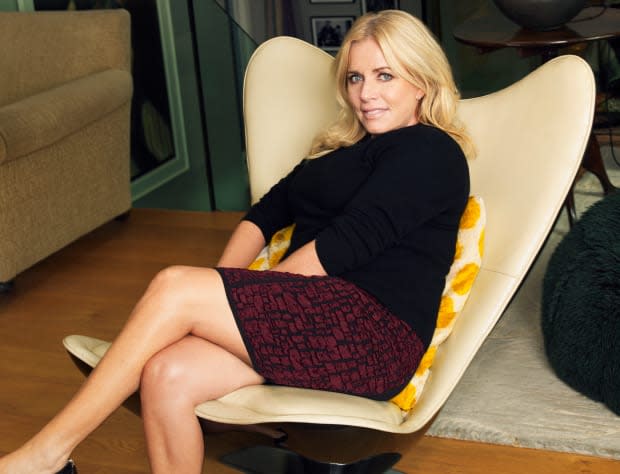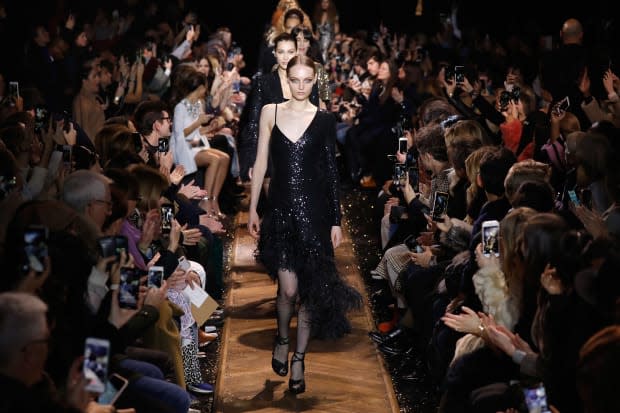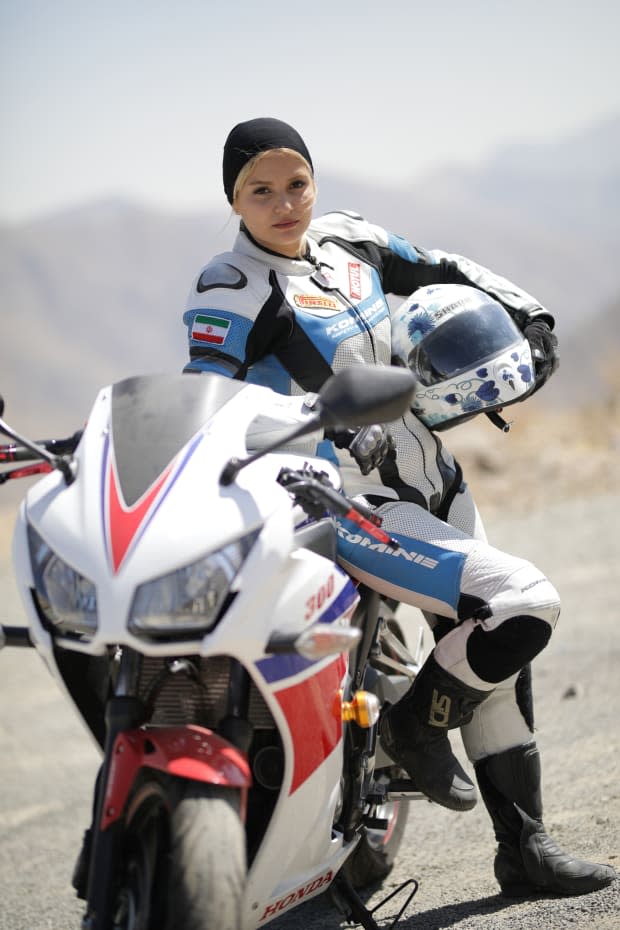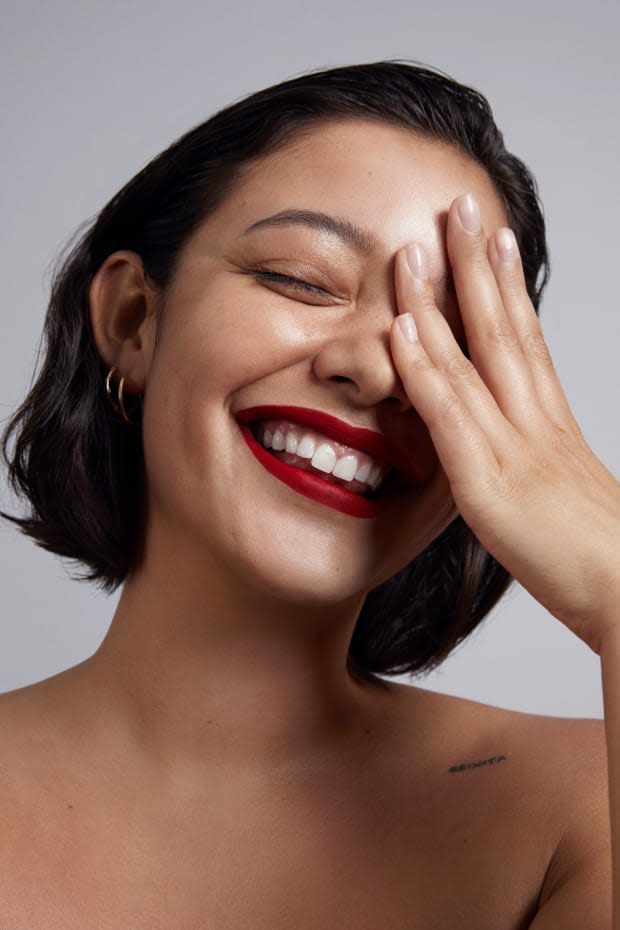How Storm Management's Sarah Doukas Went From Modeling Herself to Discovering Kate Moss and Cara Delevingne
"I've got some kind of weird radar. It's just in my being to do it," says the talented scout and businesswoman.

In our long-running series "How I'm Making It," we talk to people making a living in the fashion and beauty industries about how they broke in and found success.
Storm Management founder Sarah Doukas will go down in modern history as the person who discovered the great Kate Moss — and she didn't stop there. She also launched the careers of Cara Delevingne, Sophie Dahl and Jourdan Dunn, who all not only changed the fashion industry for the better, but also became multi-hyphenate talents in their own rights.
But scouting with such an instinct for a fresh look and charismatic personality seems to just come naturally for Doukas, whose eclectic entrepreneurial background lends itself to the rapidly shifting fashion and media industries. She actually modeled in the '70s, managed a punk band and ran antique businesses in London, Paris and Berkeley, California. Returning to London in the '80s, Doukas re-entered the modeling industry, but on the booking side. Then, in 1987, the serial entrepreneur ventured out on her own — with investment from one Sir Richard Branson — to form Storm Management, which took a unique approach to model management in the era.
Doukas started the agency with a handful of models that she scouted on her own, but her discovery of Moss — then considered "unconventional" in the age of the glamazon supes with her 5' 8" frame and grunge-y aesthetic — put Storm on the map. Since then, Doukas has continued challenging industry norms and championing inclusion in fashion, as well as staying on the forefront of the rapidly changing meaning of "model" in an influencer-dominated world.
Point: The company formerly known as "Storm Model Management" is now "Storm Management," with models just one of four divisions. In 2004, Doukas and her brother and business partner Simon expanded the portfolio to create Storm Artists, which represents multifaceted talent outside of the traditional modeling realm to secure projects, partnerships and licensing deals. The division's industry-crossover personalities include chef-multi-hyphenate Tess Ward, body-positive activist (and co-star of the Madewell Spring 2019 campaign) Naomi Shimada, British royals Amelia Windsor and Kitty Spencer, visual artist and musician Evangeline Ling of the duo Audiobooks and, staying within the Storm fam, Lottie Moss. (The elder Moss left Storm in 2016 to form her own agency.)
Realizing the impact of the influencer, Doukas launched Storm Vision in 2014 to represent digital stars for projects in a range of categories, from the younger Moss to former model, author and chef Lorraine Pascal. Two years ago, Doukas and her brother formed Storm Creative to focus on cultivating U.K-based talent, like Liv Little, editor-in-chief of Gal-dem, which celebrates the creative work of young women of color, and performer and poet Lily Ashley.
Still a model scout at heart, Doukas and her team are always out spotting fresh talent, including British Vogue November 2018 cover model Fran Summers, who just helped Barry Manilow and Bella Hadid shut down the Michael Kors Fall 2019 runway extravaganza at New York Fashion Week. (Perhaps Summers needs to be shifted over to the Storm Artists side of things?) Of course, Doukas is always on the lookout — even when she doesn't realize — as she shared with Fashionista below. Here are the highlights from our conversation.

What was the learning curve like when you started model scouting? How does one learn to become a model scout?
I just like looking at people. I'm fascinated by people. I'm very observant. I'm interested in how a face lends itself to a camera. I suppose I just learned because, back in those days — 1983, 1984 — when I came back to the U.K., agencies didn't really scout people. [Models] just walked in, I guess. When I started Storm, I didn't want to represent models from another agency and I certainly didn't want to take models from the agency that I'd left, so I went looking for faces. I started Storm with about five people that I scouted on the street.
How did you know it was time to launch your own agency?
I'd always been entrepreneurial and I'd never worked for anybody else. Although I loved working for IMG, I just knew there was nowhere else for me to [advance]. I just had it in my DNA that I had to get out and do my own thing. I didn't consider that it would be a failure because you can't when you're entrepreneurial and you want to start a business. You just literally go for it — and I went for it.
You discovered Kate Moss and launched the careers of Cara Delevingne and Sophie Dahl, who all challenged some sort of fashion industry norm at the time. What is the secret to spotting trailblazers and cultivating their careers?
I always say that when you see somebody in their natural environment — buying something at a shop, checking in at an airport, just walking around doing the daily business — you see something. Or I do. I get this feeling.
I scouted Anya Taylor-Joy about four or five years ago. She was walking her dog in Knightsbridge and she never really modeled, but she's now become a pretty famous actress ["Thoroughbreds"]. She's very lovely and she still gives me credit for finding her, which is very nice because people don't always do that. She was never going to be a model. So it happens quite often that I've found people who haven't actually modeled, but we've brought them on, as we have an acting side [in Storm Artists].
Paula [Karaiskos], my head of press has helped with that, especially with Sophie Dahl. Izzy Blow called me one day — Isabella Blow, very famous — and just said: 'I found a girl. You probably won't be interested. She's not your 'average' model.' The booking table was very reticent, but Paula and I decided to go about it alone because we saw something about her that was amazing. She's an incredibly bright, interesting person and I just thought she could break boundaries.

What are the challenges you faced in introducing groundbreakers to the industry and negotiating their first contracts?
When you decide to take on somebody who's, say, smaller than average — like Kate Moss or Cara Delevingne — or somebody not your 'traditional' model size, like Sophie Dahl was then, they face the challenges. And we do, too. Because you're going to come up against people who will say, 'she needs to lose weight' or 'she's not tall enough' and we push it and go: 'Listen, she's exceptional and you need to think out of the box a bit.'
I'm in Australia a lot. I was in Western Australia last year and I saw Behnaz Shafiei, an Iranian motocross champion, in an ad for a Danish jewelry designer. I just felt she would be amazing. So we now represent her [under Storm Artists], but there are challenges because she's Iranian and she can't shoot in the U.S. or the U.K. [due to visa restrictions]. But we don't care.
The role of a model has evolved, which brings more opportunity in cultivating their own personal brand. How has your job as an agent and scout evolved along with that shift?
Social media is great for scouting and makes it a lot easier. Five years ago, we also started an influencer division, Storm Vision, so we represent people who have their own YouTube channels. Clients now are very discerning and understand that there's no point in having five million followers if they're not authentic followers.
Now we bring on the models, who really have to develop those skills. They're not necessarily going to be traditional influencers, but [brand] clients want to know what their social media following is. So our social media team helps them understand what they should be posting, etc.
How does your social media team train models with their social media skills?
The Storm Vision team is very helpful because they're not model agents. They represent our influencers, so they are very helpful in explaining to models what they should be doing and posting. We work in this big open plan office and so there's a lot of communication and so we bring people to our in-house social media expert, Millie Kotseva, as soon as we take them on. We ask them how [many followers they have], we look at what they're posting and she guides them. We have seminars to give them the confidence to do it.
You've addressed sexism in the industry from personal experience: How has the situation evolved in light of #MeToo and #TimesUp?
I don't think for us, Storm, that it happens so much. We work with clients we know incredibly well, that they're professional. Of course, there's always going to be situations — and I can't tell you there haven't been and we've had to deal with situations — where people feel that they have been vulnerable to somebody who's taken advantage of them in our industry. But it's rare. What worries me is people who aren't quite right for modeling who go through a lesser agency and really are vulnerable to all that.
All our models who live in London, they are encouraged to come in here and sit with us all of the time. My agents are almost like psychiatrists or counselors because you only find things out when you really talk to people. That is another thing: Some people, as we know from all this Me, Too business, people have been incredibly reluctant to come out because they are terrified it's going to ruin their careers.
We do try and encourage people to talk and after every job ask them, 'How did it go? How was it? Any feedback?' It is really open house in here. It's like a family, so they do come in and sit around. In fact, too long. For hours. You have to be very perceptive and emotionally in tune with people to do this job as well as being good at your job as an agent. I don't think you should be an agent if you don't like people.

There's so much crossover in the industry now with influencers being models, actors are also influencers and models. Where do you see this all going?
I just think we work more and more internationally, exploring media partnerships and global partnerships and global talent. Storm's changed a lot. Simon, my brother and I, we cut our teeth on Kate's big contracts — probably before anybody had contracts quite like hers — and so we're really good at it and we've finely-tuned it.
But we now have a branding and licensing agent to explore really interesting partnerships and opportunities with some of our talents, like Lorraine Pascal. Although it's difficult — and it's changed — it's actually more exciting and there are more things that are possible for people. It's not just a one-dimensional business.
We've got Storm Creative now and so many of them are trail blazers in whatever they do. They feel empowered to be able to do everything. And we've got a lot of politically motivated activists. It's fantastic. It's just so bright and interesting. The thing is we used to be so governed in our business — in the fashion industry — and the lines were so defined and it just was this small little industry that only a few people could ever get involved in. Now it's huge and we represent all kinds of interesting, fascinating people.
What's one of your most memorable discovery moments?
I think you can never not mention Kate Moss in the airport. Cara Delevingne was in my daughter's school. I've known Cara since she was four years old and I always thought she would be amazing.
I nearly ran a little boy over the other night. He wasn't little; he was about 14 or 15. I was driving home in the dark and literally I came around the corner and he crossed the road with his hood on and his ear-set in and I literally nearly hit him. He took his hood off and he had the most beautiful face.
So I drove around the block and accosted him and he was terrified because he thought I was going to scream at him for walking in the road and listening to music without looking. I was in the middle of the road with my window down, shouting, 'I'm not cross. Come here, I need to talk to you!' I didn't have time to take his number and I thought, 'he's never going to remember my number,' and amazingly he gave my card to his mother. We've taken him on and his mother's delighted: number one, that I didn't kill him and number two that he's got this amazing opportunity.
I don't think I'm looking — I'm just driving or doing whatever I'm doing — but I'm always looking. I've got some kind of weird radar. It's just in my being to do it.
This interview has been edited and condensed for clarity.
Never miss the latest fashion industry news. Sign up for the Fashionista daily newsletter.
